Erection of monolithic walls: we'll talk about this in this article on the site. Monolithic walls made of lightweight concrete, compared to brick, are just as strong, but less heat-conducting and more economical. For this reason erection of monolithic walls today is gaining considerable popularity. Due to this circumstance, we have created this article. In it, we laid out in detail all the technology erection of monolithic walls do it yourself.
There are two technologies for the construction of monolithic concrete walls. Their difference lies in the use of different formwork structures. In the first option, a removable formwork is used (the structure is removed after the concrete has hardened), and in the second, a non-removable (dismantling is not provided) formwork.
Erection of monolithic walls with removable formwork
Used in the construction of monolithic walls removable formwork is made most often of metal or wood and is prefabricated. The metal formwork looks like assembled (as a constructor) panels. Wood is more popular, it is hammered from boards and plywood right on the construction site. This type of formwork can be reused.
During installation, the formwork is set to a height determined by the thickness of the concrete layer, which is planned to be poured at one time. This value can be veiled from 20 to 200 cm, and sometimes even more. The width of the formwork structure, and therefore the wall itself, is calculated based on the values \u200b\u200bof the thermal conductivity of the concrete and the region of construction.
The inner surface of the formwork (in contact with the concrete) should be as smooth as possible. For this purpose, plastic or laminated chipboard is used.
DIY construction (erection) of monolithic walls made of concrete (reinforced concrete):
- Formwork assembly and installation. Shields are assembled from boards with a thickness of 30-50 mm and bars of "ribs" nailed to their outer side. Panels (connected panels) are exposed opposite to each other. The distance between them is set with temporary spacers (horizontal bars between the boards). If the width of the walls exceeds 500 mm, then to strengthen the structure, the "ribs" are connected by "contractions" - a horizontal bar. Opposite panels are connected with tie bolts or wire strands. At the end, with a step of 1-1.5 m, spacer slope posts are installed.
- Reinforcement of monolithic walls. A reinforcing mesh (plastic or steel) is installed in the formwork, or, which is more priority, a frame made of reinforcement.
- Pouring the walls with concrete. The concrete mixture is laid in layers (no more than 50 cm). Pouring of each subsequent layer takes place after the "setting" of the previous one. The poured mixture is compacted with a deep vibrator. After the concrete has hardened, the formwork is moved to a higher level, after which concreting continues.
For the purchase of concrete maximum strength it will take 4-5 weeks. After this period has expired, you can proceed to insulation and finishing.
A wall reinforced with reinforcement, the diameter of which is 8 mm or more, will be quite cold. The reason for this is the "cold bridges" that create the metal parts of the frame.
In the case when monolithic walls houses are built using instead of conventional concrete can be used mixtures with much lower thermal conductivity. These include: expanded clay concrete, slag concrete, perlite concrete, sawdust concrete, wood concrete, etc. Walls made of such materials will be warmer, but at the same time less resistant to increased loads.
Erection of monolithic walls with fixed formwork
Fixed formwork used in the construction of monolithic walls of a house is a block or panel made of various materials. They are mounted in a formwork structure, which is reinforced and poured with concrete. After the concrete has set such formwork cannot be removed, it becomes a functional part of the wall.
The most common type permanent formwork - blocks (thermoblocks) made of expanded polystyrene with voids. These are plates (usually 50 mm thick) located at an average distance of 150 mm from each other and interconnected by removable or non-removable jumpers.
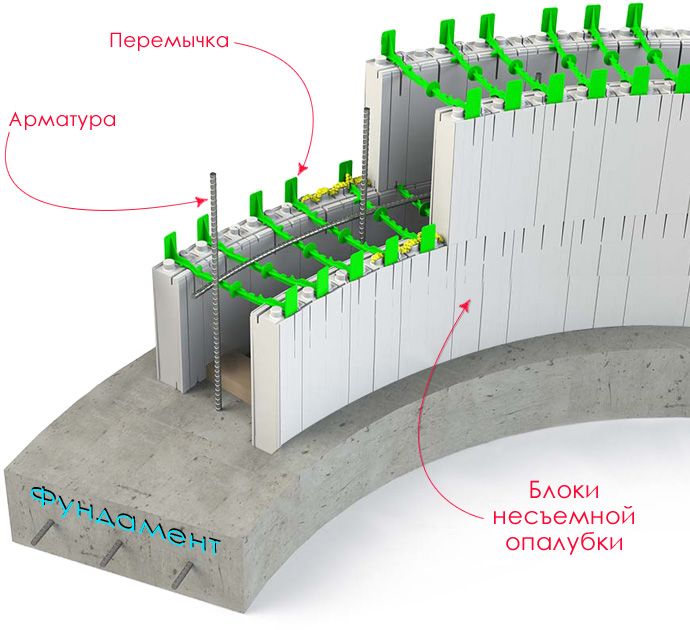
Do-it-yourself construction of monolithic concrete walls:
- Formwork installation: fixed formwork elements are laid on the prepared foundation surface. The blocks are fastened to each other using connecting “locks”. They provide the structure with the required level of tightness and exclude the possibility of concrete leakage. The formwork is erected to a height of 50 cm. After pouring the concrete, the next "batch" of blocks is laid out. During this time, the concrete has time to dry out. Thus, work is practically not interrupted.
- Reinforcement of fixed formwork: horizontal reinforcement bars are laid in special grooves of the blocks. Next, vertical reinforcement is installed. The rods are connected with a knitting wire.
- Pouring the formwork concrete: the concrete mixture is laid in a layer of 50 cm (at the height of the formwork: point 1) and compacted with a deep vibrator.
- House wall decoration. By result construction works walls are obtained in the form of a "sandwich", where reinforced concrete is located between two plates of expanded polystyrene. Such a structure needs protection from mechanical damage, as well as a fireproof covering. For this, the walls of the house, both from the front and from the inside, are finished with non-combustible material (with a layer of at least 30 mm): drywall, plaster.
Formwork blocks are supplied standard sizes, therefore, they have to be adjusted on site by sawing.
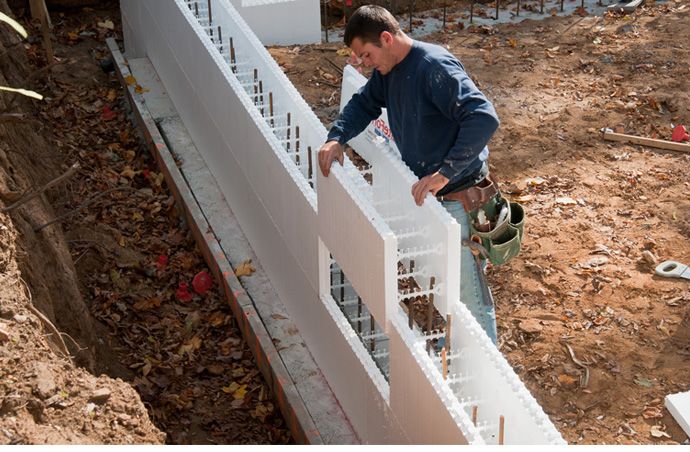
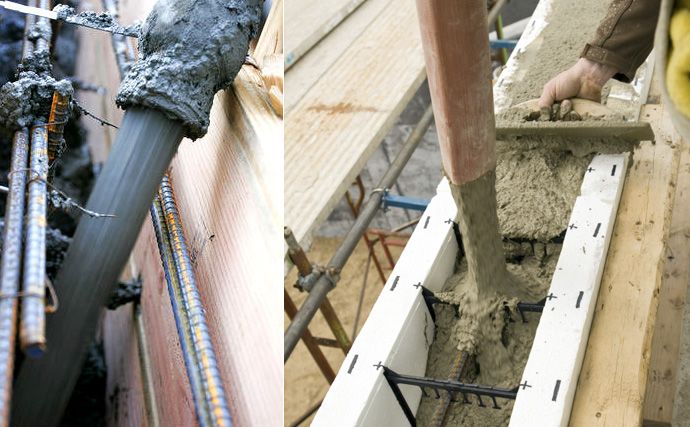
Only concrete should be used for casting the permanent formwork. The use of warm mixtures is prohibited. The reason is that the vapor permeability of polystyrene foam is lower than that of warm mixtures - 0.05 Mg / (m * h * Pa) on 0.09 Mg / (m * h * Pa)... Consequently, condensation will inevitably accumulate in warm concrete compressed between expanded polystyrene. And this will inevitably lead to the formation of mold and mildew.
Types of concrete solutions for monolithic construction
Monolithic construction allows the use of solutions with different thermal conductivity and vapor permeability:
- Concrete - a cottage with such walls needs insulation. The reason for this is the high thermal conductivity of the material 1.51 W / (m * C) with a vapor permeability of 0.03 Mg / (m * h * Pa);
- Reinforced concrete is even colder than concrete, since the reinforced frame acts as a "cold bridge";
- Expanded clay concrete - with such walls, the house will be warm enough. The thermal conductivity of expanded clay concrete is 0.66 - 0.14 W / (m * C) with a vapor permeability of 0.09 - 0.3 Mg / (m * h * Pa). These indicators may vary depending on the density of the mixture (the larger the porosity of expanded clay concrete, the warmer the walls will be);
- Slag concrete - slag concrete. The same expanded clay concrete is only less durable;
- Sawdust concrete is a mixture of cement, sand, sawdust (needles) and water. Such walls will be warm, durable, fire resistant and environmentally friendly. But there is one thing, such material must be covered with a waterproofing layer;
- Arbolit (wood concrete) is a compound of wood chips with cement. Compared to sawdust concrete, the material is more durable and warm;
- - aerated concrete obtained by hardening a mixture of cement, sand, water and a foaming agent. The material has a thermal conductivity of 0.29 - 0.08 W / (m * C), together with a vapor permeability of 0.11 - 0.26 Mg / (m * h * Pa).
During the construction of structures and buildings, hollow walls are often made of reinforced concrete. However, few people know what these walls are and what their characteristics are. Therefore, before using these structures for construction, it is worth studying all their features.
Types of reinforced concrete slabs
Depending on the composition and type of construction, there are the following types:
- Reinforced concrete slabs with solid construction. These products are manufactured in different sizes... Their length varies between 1790-6260 mm, width 1200-4500 mm, and thickness 120 mm, 170 mm, 210 mm. This type of product has a large mass. Their weight depends on the dimensions of the slab itself and ranges from 0.625 tons to 3.7 tons. The height size reaches 220 mm. These products are used to cover walls in residential and
- Slabs with round voids. They are also quite large structures. Slabs with a width of 100 mm have a length of 240-1200 mm, with a width of 120 mm - 170-890 mm, with a width of 150 mm - 240-890 mm. Their height reaches a maximum of 220 mm. But unlike a solid floor slab, reinforced concrete hollow-core slabs have good sound insulation and thermal insulation. These indicators are provided due to the presence of voids in the inner part of the slab.
- Plates for special purposes. These designs are only suitable for balconies, loggias, bay windows and plumbing fixtures. Their difference lies in the fact that the structure has special holes for laying pipes. The height of these structures is 200 mm.
- Ribbed slabs. They are used to overlap brick residential and public buildings, also very often used for arranging the load-bearing base of the roof. They are very large. Their length can reach up to 18 meters, width - 3 meters, and height - from 600 mm to 800 mm.
- Spacer slabs. They are installed between the columns of buildings. The length of these slabs reaches 1.5 meters.
- Heavy concrete slabs. These structures are installed between the columns on the ground floor.
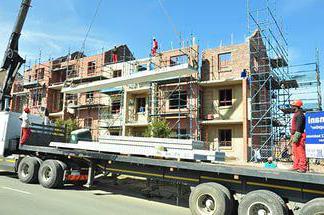
Features of walls made of hollow core slabs
Currently, hollow core slabs are used in the construction of walls in many buildings, including residential buildings. This is understandable, because the hollow walls made of reinforced concrete have the best characteristics and qualities.
It is worth paying special attention to the following features of these structures:
- Due to the fact that the panels have voids, they are very easy to install and the load on the walls is significantly reduced.
- The voids provide good thermal insulation, and therefore the walls do not need to be additionally insulated.
- Another good feature is soundproofing. Despite the fact that it does not change from reinforced concrete, the sound insulation is very high. External sounds and noise practically do not penetrate through the walls.

Selection criteria for slabs for hollow walls
It is especially important to choose the right structures for the construction of hollow walls. Therefore, before you start making hollow walls from reinforced concrete, you should pay attention to the properties of the slabs.
Many people think that they differ only in parameters and sizes, but this is not entirely true. Hollow-core panels also have distinctive characteristics that are useful in the construction of houses and public buildings.
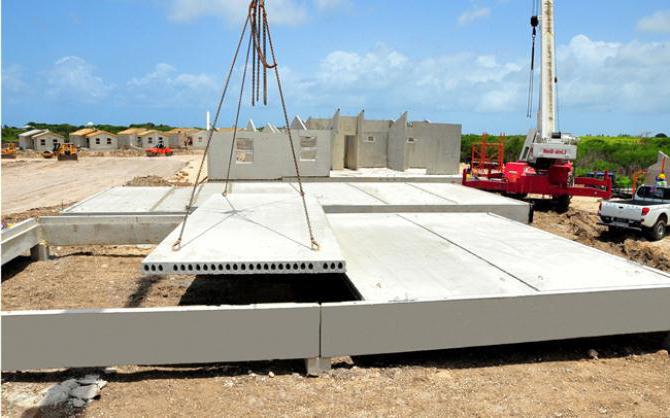
Distinguishing criteria for hollow core panels
- The first distinguishing characteristic is the way of reinforcement. Depending on the type of slab, the reinforcement can be with or without prestressed reinforcement. Panels with prestressed reinforcement are especially often used in construction.
- Another important feature is the number of support sides of the entire structure. Basically, all hollow structures can only be supported on two short sides. But sometimes there are structures with supports on three or four sides.
- It is worth paying attention to the method of making the plates. Basically, hollow-core reinforced concrete slabs are produced with two markings PC or PB. Depending on this, the method of manufacturing the structure of these products is different.
Differences between PB hollow core panels and PC
Panels under the PB brand are manufactured using continuous formwork casting. They have a flat and smooth surface, and they hardly crack. These structures use Reinforced concrete slabs of this type can be easily cut lengthwise or into separate pieces, and they can also be made oblique at an angle of 30 to 90 degrees. Moreover, their basic structure is not violated. These properties make the work on the construction site much easier.
Plates under the PK brand are cast in the formwork. With a length of up to 4.2 meters, they can be produced without prestressed reinforcement. In addition, they have free deflection.

Features of installation of slabs during the construction of hollow walls
Of course, in order for the hollow walls made of reinforced concrete to be strong and strong, it is necessary to install the panels correctly.
Installation of hollow walls consists of the following steps:
- Since hollow-core slabs of the PB brand do not have mounting loops for installation, loading and unloading of these structures should be carried out using soft rods or a special traverse.
- In order to pull the pry out from under the panel, leave a small gap before the next panel during laying. Further already installed plate should be moved with a crowbar to an adjacent panel.
- It is worth observing the value of the minimum depth of the structure support. These indicators depend on the type of wall. For example, for brick walls, the minimum depth should be 8 cm, and the largest 16 cm, for a reinforced concrete wall, respectively, 7 cm and 12, for gas and foam concrete blocks - from 10 to 15, for steel structures - 7 cm.
- Before starting the installation of panels, it is necessary to hammer the ends of the holes with voids. Voids can be repaired with pieces of wood or bricks. This is done so that water does not get into the structure. Due to this, the service life of the hollow walls increases, they do not crack, do not crumble.
- After the complete installation of the slabs, it is necessary to anchor and fill the gaps with cement. In the case of PK marking plates, the anchor is hooked onto the mounting lug and the void is filled with cement.
Also, before proceeding with the installation of hollow structures, a crane should be ordered. It is important to take into account the size of the approach paths, the maximum possible reach of the crane boom and the possibility of the permissible weight of the crane.
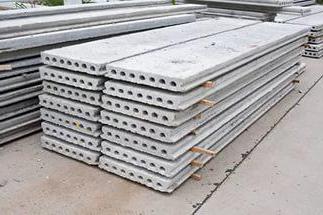
The cost of reinforced concrete hollow structures
Few people know how much hollow reinforced concrete costs, the price of this product is different everywhere. Of course, it all depends on the quality and design of this product.
A PC brand stove costs from 2 to 12 thousand rubles. And panels of the PB brand cost from 1,500 to 15 thousand rubles. The cost of these products depends on the size of the structure, quality and composition. The higher the quality and the larger the plate, the correspondingly higher the price of the product.
For the construction of walls of low-rise buildings that do not require increased strength, lightweight concrete, both monolithic and small-block, is widely used. With the relative cheapness and ease of construction, such walls have good operational properties.
Slag, expanded clay, brick breakage, sawdust reeds and other local materials are used as aggregates in the manufacture of lightweight concrete. Cement, lime, clay, gypsum serve as a binder.
The most common slag concrete based on fuel or metallurgical slag. To increase the strength, 10-20% of sand is added to it (from the volume of slag).
Slag must be clean and free of foreign impurities: earth, clay, ash, unburned coal and debris. In order to reduce the content of unbaked clay particles and harmful salts, fresh slag is kept for a year in dumps in the open air, providing free drainage of rain and flood waters during storage.
The strength and heat-shielding qualities of slag concrete largely depend on its granulometric composition, then on the ratio of large (5-40 mm) and small (0.2-5 mm) parts of the slag aggregate. With coarse slag, concrete turns out to be lighter and less durable, with small slag - more dense and heat-conducting. For external walls, the optimal ratio of small and large slag is from 3: 7 to 4: 6, for internal load-bearing walls, where the main advantage is strength, this ratio changes in favor of fine slag, and lump slag with a size of more than 10 mm in the composition of slag concrete in this case do not include at all.
As a binder, cement with lime or clay additives is used. The additives reduce the consumption of cement and make the cinder concrete more plastic.
Tentative composition of cinder concrete.
To prepare cinder concrete, cement, sand and slag are mixed (large pieces are pre-moistened), then lime and clay dough, water are added and everything is thoroughly mixed again. The finished mixture is used for 1.5-2 hours.
Monolithic cinder-concrete walls are erected in a movable formwork 40-60 cm high, knocked down from four centimeter boards. The inner surface of the boards is covered with foil or pergaline. Formwork panels are usually attached to fixed posts with a diameter of 10-15 cm, installed on both sides of the future wall every 1-1.5 m along the front to the full height. Temporary spacers are inserted inside the shields, and wedges are inserted between the posts and the shields.
The thickness of the walls made of monolithic slag concrete is 55-60 cm, when used as a filler of expanded clay, pumice, the thickness can be less - 45-50 cm, walls for garden houses can be reduced to 35-40 cm.
Slag concrete is laid in layers of 15-20 cm with uniform tamping and bayonet. After two or three days, and in warm weather after a day, the formwork is rearranged. The laid cinder concrete is shaded from direct sunlight for seven to ten days, and periodically moistened in dry weather.
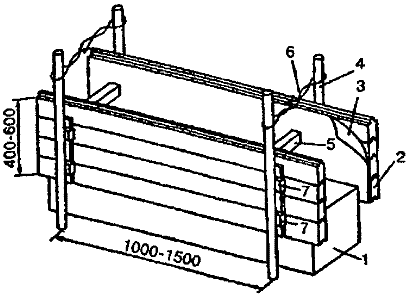
: 1 - slag concrete; 2 - formwork panel, 3 - glassine; 4 - racks, 5 - spacer; 6 - wire twisting; 7 - wedges.
Monolithic walls can be erected with internal voids. This increases the heat-shielding qualities of the walls and reduces the consumption of cinder concrete. Liners made of lighter concrete, foam, old newspapers and cardboard, milk bags, etc. can be used as voids. However, it should be borne in mind that voids weaken bearing capacity walls, so the strength of cinder concrete in this case must be increased. It is possible to finish (plaster) monolithic walls no earlier than three to four weeks after their construction, when the cinder concrete is completely dry and gains the necessary strength.
From the outside, the block walls are plastered with Cement-sand mortar, from the inside, they are faced with sheets of dry plaster. A good technological solution is obtained when constructing monolithic cinder-concrete walls with external brick cladding, which gives the wall a more capital appearance, does not require subsequent finishing (with brickwork with jointing), and in the process of concreting it serves as an external formwork.
Lintels over door and window openings 6 walls made of lightweight concrete are usually arranged, that is, along the masonry from a monolithic reinforced concrete belt with a thickness of 30-40 mm, laid along wooden formwork, or from wooden blocks 1/20 of the span. The length of the support parts of the lintels is 40-50 cm on each side of the opening.



